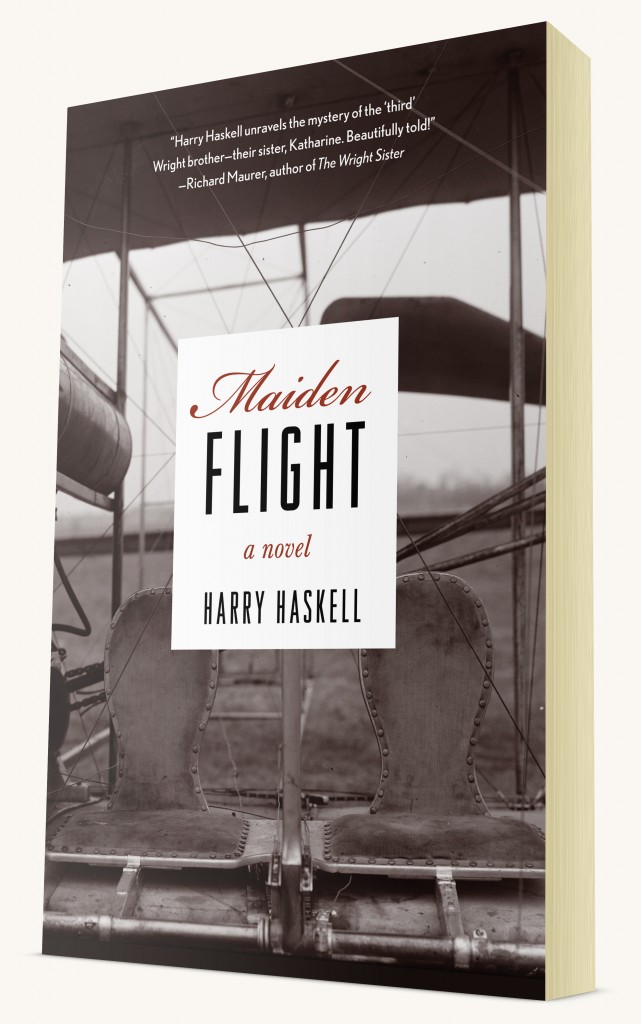 Harry Haskell is the author of Maiden Flight, a novel tracing the life and love of Katharine Wright, sister of famous inventors Wilbur and Orville. In the book, Haskell shares Katharine’s path as she painfully separates herself from supporting Orville in order to pursue a romantic relationship with Harry J. Haskell—the author’s grandfather. Richard Maurer, author of The Wright Sister, says Haskell “unravels the mystery of the ‘third’ Wright brother—their sister, Katharine. Beautifully told!” Here Harry explains Katharine’s relationship with both Orville and her husband, how he used Katharine’s love letters to write the book, and why her story still resonates today.
Harry Haskell is the author of Maiden Flight, a novel tracing the life and love of Katharine Wright, sister of famous inventors Wilbur and Orville. In the book, Haskell shares Katharine’s path as she painfully separates herself from supporting Orville in order to pursue a romantic relationship with Harry J. Haskell—the author’s grandfather. Richard Maurer, author of The Wright Sister, says Haskell “unravels the mystery of the ‘third’ Wright brother—their sister, Katharine. Beautifully told!” Here Harry explains Katharine’s relationship with both Orville and her husband, how he used Katharine’s love letters to write the book, and why her story still resonates today.
Tell us a little about Katharine and her relationship with her brothers. What role did she play in their lives?
Katharine and “the boys,” as she called Wilbur and Orville, were virtually inseparable. As David McCullough shows in his recent biography of the Wright brothers, she was intimately involved in practically every aspect of their lives, both personal and professional. Katharine was the only member of the family with a college degree, and despite her persistent denials, it was widely reported that she helped her brothers with the mathematical computations for the airplane—a myth that did wonders for her reputation, but irritated Orville no end.
Most people don’t know that Katharine had four older brothers. The two eldest, Reuch (pronounced “Roosh”) and Lorin, married and left home when she was young, so she was never as close to them as she was to Wilbur and Orville. After Will died of typhoid fever in 1912, she and Orv grew closer than ever—so close that visitors to their big home in Dayton sometimes mistook them for a married couple. In fact, they were born on the same day, August 17, exactly three years apart. We celebrate the date as National Aviation Day, in Orville’s honor, but Katharine deserves her share of the limelight too!
Much of Maiden Flight stems directly from Katharine’s love letters to Harry (your grandfather). What’s your relationship to Katharine, and how did you gain access to the letters? Would you have been able to write this book without them?
Katharine was my grandfather’s second wife, so I guess that makes her my step-grandmother. She and Harry (he and I are namesakes, which can be a bit confusing at times!) met as undergraduates at Oberlin College in the 1890s. Although they clearly “clicked” way back then, Harry was already engaged, and it wasn’t until after the death of my grandmother—whom Katharine had also known slightly at Oberlin—that they finally got married in 1926.
Maiden Flight is the story of how these two not-so-proper Victorians, both in their early fifties and both the products of strict religious upbringings, fell head over heels in love—in Katharine’s case for the first time in her life. It was a storybook romance, as Katharine’s marvelous love letters to Harry make clear, and it might have had a storybook ending—if it hadn’t been for Orville. He insisted that his sister had implicitly agreed to look after him for the rest of his life. When Katharine ran off (as he saw it) with Harry and moved to Kansas City, he felt not just abandoned but betrayed and cut off all communication with her. Tragically, he saw her only once more, on her deathbed in early 1929.
According to their nieces and nephews, Uncle Orv never spoke of his sister again in the remaining two decades of his life. But for the rest of his life Harry reread her love letters every year on the anniversary of her death. It’s because he saved them that I have these extraordinary documents in my writing studio today. This epistolary treasure trove not only inspired me to tell the moving story of their love affair, but made it possible for me to tell it largely from Katharine’s perspective and in her own words.
You chose to write the book from three different perspectives—Katharine’s, Orville’s, and Harry’s. How did you decide on this technique?
My original subtitle was “Katharine and Orville Wright—and the Man Who Came Between Them.” One of the things that always fascinates people when I share their story is that the three protagonists in this lovers’ triangle were often flying blind, acting and reacting without being in “full possession of the facts,” as the scientist in Orv would say. Letters were constantly getting delayed or crossing in the mail. Innocent deceptions gave rise to misunderstandings with unforeseen consequences. Harry didn’t confess his love to Katharine until long after my grandmother died. Katharine, wary of hurting Orv, hid their engagement from him for over a year. And Orville refused to broach the subject even after he had learned about their plans from his brother Lorin.
Talk about a comedy of errors! It’s understandable that Katharine, Orville, and Harry were less than completely candid with each other. What makes the story so rich and compelling on a human level is that often they weren’t even aware of their own feelings and motivations. It’s these tangled emotions and psychological complexities that I wanted to capture in Maiden Flight. I finally decided that I couldn’t achieve that sense of lived experience in a conventional historical narrative. Instead, I created what I call a “contrapuntal medley” of three interwoven memoirs that I hope will help readers hear the voices of these three fascinating individuals as vividly as I hear them.
You’ve said that Maiden Flight is “an exercise in imaginative reconstruction.” Can you explain?
All three of my earlier books are conventional historical nonfiction. I’ve always thought of myself as a nonfiction writer, and in fact the archival research I did for Maiden Flight is as extensive and rigorous as any I’ve ever undertaken. As I explain in the book, every incident, fact, and emotion that Katharine, Orville, and Harry describe is either explicitly documented or can be plausibly inferred from the historical record. That’s what I mean by “reconstruction.”
As for the “imaginative” part, I realized from the beginning that I couldn’t simply reprint Katharine’s letters verbatim and expect her story to make sense to readers, let alone hold their attention. I needed to arrange them more or less artfully—to extract the “juicy” bits and stitch them together with connective tissue of my own invention. At a rough guess, 80 percent of the words Katharine speaks in the book are her own, with only minor alterations of tense, pronouns, punctuation, and so on. For Orville and Harry, I had fewer letters and other source documents to work with, so the proportion of “original” material in their memoirs is somewhat lower.
Although the publisher chose to label Maiden Flight a novel, I prefer to think of it as creative nonfiction. Either way, I hope readers will recognize and respond to the authenticity that comes from having the principal characters speak for themselves—at least as far as it was in my power to do so!
Your previous book was a history of the Kansas City Star, where your grandfather was editor. What drew you to write about your family history?
Actually, Grandfather wasn’t the only one in our family who worked for the Star; my father and I did too. The paper they knew was employee-owned, and thus at least nominally independent of outside interests, and nationally respected for both its reporting and its writing. Not long after I arrived in 1976, though, the Star was sold to the first of a series of corporate owners. They completed its transformation from a crusading, trust-busting newspaper, in the era of Teddy Roosevelt, to an exemplar of comparatively bland corporate journalism—what one critic called a “Main Street paper.”
I became interested in this process and what it boded for the future of American newspapers, cities, and democracy. Since the transformation took place largely during my grandfather’s era at the paper, the first five decades of the twentieth century, it occurred to me to make him the focal point of the larger story I wanted to tell. In other words, I used family history not as an end in itself but as a tool to explore issues of wider interest and significance.
Because Grandfather died before I was born, I decided to try to get to know him through the eyes of people who lived and worked with him. One of those people, of course, was Katharine Wright. I had always known about her love letters to Grandfather, which were lying around the house when I was growing up. (Unfortunately, we only have one side of their correspondence—his love letters to her have mysteriously disappeared.) But I assumed they were just romantic mush that wasn’t worth slogging through. When I finally got around to reading them, however, I discovered that Katharine was much more than a lovesick spinster or a devoted sister to Wilbur and Orville. She was a magnificently human, even tragic figure in her own right—a bright, brave, passionate woman who followed her heart and suffered the unhappy consequences.
 What do you think it is about Katharine’s story that speaks so forcefully to modern readers—especially, perhaps, women?
What do you think it is about Katharine’s story that speaks so forcefully to modern readers—especially, perhaps, women?
Despite being an exceptionally gifted member of an iconic American family, Katharine faced many of the same tradeoffs that women do today in balancing the competing demands that society places on them. In her case, the struggle was complicated by the agonizing, and ultimately irreconcilable, conflict between loyalty to Orville and love for Harry. To put it another way, she was torn between the Victorian values of her youth and the values of the modern world that her brothers helped to create.
Before the First World War, Katharine was one of the most famous women in the world. And yet her sense of duty led her to give up her own career as a high school teacher to become her brothers’ paid “social manager” and general dogsbody. To me, one of the most poignant aspects of her story is the chronic fatigue she described in her letters. She complained of having no meaningful work to do and predicted that no one would understand if she left Orv on his own. It’s Katharine’s unflinching quest for independence and fulfillment, I think, that makes her experience both timeless and universal.
Photos of Katharine, Harry, and Orville are courtesy Special Collections and Archives, Wright State University.
Maiden Flight by Harry Haskell officially publishes on October 1, 2016 and is available wherever books and e-books are sold. Visit harryhaskell.com for more information.
[Get a copy $16] [Request a review copy]
2 Comments
Having known and interviewed her niece Ivonette Wright, nephew Horace and grand nieces and nephews over several years and considered a friend, I know that they would be horrified at this intrusion. They were extremely private individuals.
I would not purchase or read.
Found your book at the Essex CT Library and was sorry to have missed when you spoke there. Beautiful read, thank you!
Jill Butler